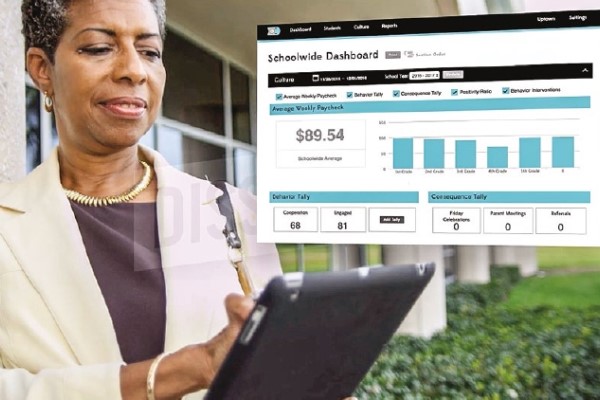Adding School Climate and Culture to the Data Mix
April 01, 2017

What’s the first thing that comes to mind when you hear the word “data”? Is it student test scores and academic achievement data? Or perhaps administrative data about student demographics? All are important aspects of a school leadership role, but research suggests there’s additional — and often overlooked — data that can significantly affect student learning and academic achievement: school climate and culture data.
A positive school culture is one where students feel engaged and invested in their learning. When students feel unsupported — or worse, unsafe — they disengage from their teachers, peers and learning, and attendance and behavioral problems may arise. Conversely, when schools become physically and emotionally safe, students engage and districts succeed.
Of course, data alone can’t change a school’s culture. The real solution is their use by leadership. Data just happen to be the best tools at the disposal of an effective leader. A data-driven leader knows how to use data to drive the insights and action plans that actually improve student learning every day, in every classroom and school. But how do you expand this to become a data-driven culture leader as well?
Fortunately, it doesn’t mean you have to spend hours every day poring over spreadsheets and notes. In fact, with the right technology, you can find plenty of time to practice data-driven leadership that leverages real-time insights to address school culture, classroom management and student behavior challenges and to create opportunities for success.
With a student information system in the back of the house connected to a school culture management system in the front, you can manage all the data points and insights that matter, including student behavior, character strengths, Positive Behavior Interventions and Supports, early-warning indicators, interventions, attendance and more. The key is that the technology should do all the visualizations and tabulations behind the scenes, so you can spend your time where it matters most — using insights to drive action.
Dashboard Driven
Here are a few exercises to take the first steps to becoming a data-driven culture leader:
- Schedule a few minutes at the beginning of every day to check school and classroom culture dashboards.
This will allow you to analyze how behavior and discipline may be affecting academic performance. A good place to start is to look at the positivity ratio for your district, schools, grade levels, teachers or classes. The positivity ratio is a ratio of positive to negative behaviors that are being recognized. Negative behaviors tend to stick longer with students, and it takes a lot of positive reinforcement to get a child back on track. Research shows that a positivity ratio of 3:1 — recognizing three positive behaviors for every one negative behavior — is optimal.
Having these data at your fingertips can focus conversations with teachers or grade-level teams to make sure they’re providing enough positive reinforcement to students.
Are there key behaviors that are important for your school or district to monitor? For example, if bullying is an issue, use this time to look at the number of bullying incidents recorded. Or if your school is covering a new unit of a social-emotional curriculum, check to see if teachers are actively reinforcing the targeted behaviors or character strengths.

Doing a quick visual scan of real-time culture data can make it easier to plan your agenda for the day or week. In addition, if you identify issues, then you can dig deeper into the data to determine how to address them before they become bigger problems.
- Take a quick glance at culture leaderboards.
A leaderboard provides a ranking of students’ merit totals, which may be filtered by daily average, weekly average or total balance. This enables you to see the total number of points earned by individual students, groups of students, classes or teachers. Engage principals, teachers and students in celebratory conversations about culture successes to identify classroom management or leadership strategies that should be replicated to ensure continued success.
- Sort culture-based academic reports in various ways. This allows you to identify which learning communities may need additional support.
- Look at multischool culture dashboards. These can provide a one-minute review of overall school performance. They make it easier to prioritize and set aside time for school leaders who need the most support.
- Look at early-warning dashboards. These help teachers deliver the right supports to students who are beginning to struggle.
- Schedule regular data meetings.
A data meeting creates a forum where leaders and teachers can collaborate to analyze data and discuss how to move forward. Use this time to provide guidance that promotes data-driven instruction and a positive culture in classrooms. If a class performs lower than expected on an assessment, the academic data may be only part of the picture. Were there behavioral issues that day? Were students on task and engaged when the standard was being taught or were they distracted or absent from class? Even the best curriculum isn’t going to have an impact if students aren’t in class, on task and engaged in the material.
The outcome of each data meeting should be a structured action plan that can be implemented right away to address up-to-the-minute school, classroom and student successes and challenges. After the meeting, real-time data can provide insights into how the action plan is actually working. Then by the time the next data meeting rolls around, action plans can be honed to keep the momentum going in the right direction.
Gauging Positivity
With the exception of data meetings, all of these exercises should take just a few minutes with the right technology. By regularly accessing this information, district and school leaders can see behind classroom doors to determine if their schools are being as positive and effective as they can be. With these data, they can make changes or provide support as needed.
By building and sustaining a strong school culture, districts and schools can positively impact student academic achievement and teacher satisfaction, as well as the bottom line. When teachers and students have more positive interactions, classroom disruptions decrease. This not only creates a better environment but more time for effective teaching and learning. Fewer major disciplinary events also means fewer suspensions. In addition, when students feel safe, engaged and connected to the school community, attendance and graduation rates rise. Teacher turnover decreases as well.
By carving out just a little time every day to stay up-to-date on school climate and culture indicators, you can gain key insights to drive improvement and provide the right supports at the right time so all teachers and students can succeed in the school environment.
Author
Advertisement
Advertisement
Advertisement
Advertisement




